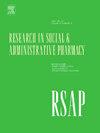A conceptual framework for identifying and managing system vulnerabilities for diversion of controlled substances in healthcare
IF 3.7
3区 医学
Q1 PUBLIC, ENVIRONMENTAL & OCCUPATIONAL HEALTH
Research in Social & Administrative Pharmacy
Pub Date : 2025-01-06
DOI:10.1016/j.sapharm.2025.01.001
引用次数: 0
Abstract
Purpose
Diversion or theft of controlled substances is a recognized problem affecting healthcare systems globally. The purpose of this study was to develop a framework for identifying and characterizing system factors leading to vulnerabilities for diversion within hospitals.
Methods
We applied a qualitative framework method, which involved 1) compiling a list of critical diversion vulnerabilities through observations and proactive risk analyses in the inpatient pharmacy, emergency department and intensive care unit of two Canadian hospitals; 2) coding the vulnerabilities into deductively and inductively derived themes and subthemes; and 3) building a conceptual framework.
Results
Our framework for diversion demonstrates how mitigating downstream diversion outcomes (e.g., harms to patients, healthcare workers, and institutions) requires the redesign of upstream system factors associated with pilfering and forgery processes. We identified 20 subthemes associated with the following five overarching themes of system factors contributing to diversion risk: task (e.g., variation in how work was done or lack of verification), person (e.g., use of insider knowledge or collaboration among staff), tools/technologies (e.g., limitations of electronic systems to identify discrepancies), organization (e.g., cultural/behavioural norms or hospital policies for controlled substance management), and internal environment (e.g., layout of the space).
Conclusion
The Diversion Framework is a conceptual model developed for use by practitioners, researchers, and policy makers to identify system factors and analyze medication-use processes that may be vulnerable to diversion. This in turn can inform safeguards to prevent harm to patients, healthcare workers and the institution.
用于识别和管理医疗保健中受控物质转移的系统脆弱性的概念性框架。
目的:转移或盗窃管制物质是影响全球卫生保健系统的公认问题。本研究的目的是建立一个框架,用于识别和表征导致医院内部转移脆弱性的系统因素。方法:采用定性框架方法,1)通过对加拿大两家医院的住院药房、急诊科和重症监护室的观察和前瞻性风险分析,编制关键转移脆弱性清单;2)将漏洞编码为演绎和归纳衍生主题和子主题;3)构建概念框架。结果:我们的转移框架展示了如何减轻下游转移结果(例如,对患者、医护人员和机构的伤害)需要重新设计与盗窃和伪造过程相关的上游系统因素。我们确定了20个子主题,这些子主题与导致转移风险的系统因素的以下五个总体主题相关:任务(例如,工作方式的差异或缺乏验证)、人员(例如,内部知识的使用或员工之间的协作)、工具/技术(例如,识别差异的电子系统的局限性)、组织(例如,受控物质管理的文化/行为规范或医院政策)和内部环境(例如,空间布局)。结论:转移框架是一个概念性模型,供从业人员、研究人员和政策制定者使用,以识别系统因素并分析可能易受转移影响的药物使用过程。这反过来又可以为保障措施提供信息,以防止对患者、卫生保健工作者和机构造成伤害。
本文章由计算机程序翻译,如有差异,请以英文原文为准。
求助全文
约1分钟内获得全文
求助全文
来源期刊

Research in Social & Administrative Pharmacy
PUBLIC, ENVIRONMENTAL & OCCUPATIONAL HEALTH-
CiteScore
7.20
自引率
10.30%
发文量
225
审稿时长
47 days
期刊介绍:
Research in Social and Administrative Pharmacy (RSAP) is a quarterly publication featuring original scientific reports and comprehensive review articles in the social and administrative pharmaceutical sciences. Topics of interest include outcomes evaluation of products, programs, or services; pharmacoepidemiology; medication adherence; direct-to-consumer advertising of prescription medications; disease state management; health systems reform; drug marketing; medication distribution systems such as e-prescribing; web-based pharmaceutical/medical services; drug commerce and re-importation; and health professions workforce issues.
 求助内容:
求助内容: 应助结果提醒方式:
应助结果提醒方式:


